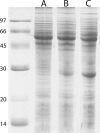Synthesis Gas (Syngas)-Derived Medium-Chain-Length Polyhydroxyalkanoate Synthesis in Engineered Rhodospirillum rubrum
- PMID: 27520812
- PMCID: PMC5068169
- DOI: 10.1128/AEM.01744-16
Synthesis Gas (Syngas)-Derived Medium-Chain-Length Polyhydroxyalkanoate Synthesis in Engineered Rhodospirillum rubrum
Abstract
The purple nonsulfur alphaproteobacterium Rhodospirillum rubrum S1 was genetically engineered to synthesize a heteropolymer of mainly 3-hydroxydecanoic acid and 3-hydroxyoctanoic acid [P(3HD-co-3HO)] from CO- and CO2-containing artificial synthesis gas (syngas). For this, genes from Pseudomonas putida KT2440 coding for a 3-hydroxyacyl acyl carrier protein (ACP) thioesterase (phaG), a medium-chain-length (MCL) fatty acid coenzyme A (CoA) ligase (PP_0763), and an MCL polyhydroxyalkanoate (PHA) synthase (phaC1) were cloned and expressed under the control of the CO-inducible promoter PcooF from R. rubrum S1 in a PHA-negative mutant of R. rubrum P(3HD-co-3HO) was accumulated to up to 7.1% (wt/wt) of the cell dry weight by a recombinant mutant strain utilizing exclusively the provided gaseous feedstock syngas. In addition to an increased synthesis of these medium-chain-length PHAs (PHAMCL), enhanced gene expression through the PcooF promoter also led to an increased molar fraction of 3HO in the synthesized copolymer compared with the Plac promoter, which regulated expression on the original vector. The recombinant strains were able to partially degrade the polymer, and the deletion of phaZ2, which codes for a PHA depolymerase most likely involved in intracellular PHA degradation, did not reduce mobilization of the accumulated polymer significantly. However, an amino acid exchange in the active site of PhaZ2 led to a slight increase in PHAMCL accumulation. The accumulated polymer was isolated; it exhibited a molecular mass of 124.3 kDa and a melting point of 49.6°C. With the metabolically engineered strains presented in this proof-of-principle study, we demonstrated the synthesis of elastomeric second-generation biopolymers from renewable feedstocks not competing with human nutrition.
Importance: Polyhydroxyalkanoates (PHAs) are natural biodegradable polymers (biopolymers) showing properties similar to those of commonly produced petroleum-based nondegradable polymers. The utilization of cheap substrates for the microbial production of PHAs is crucial to lower production costs. Feedstock not competing with human nutrition is highly favorable. Syngas, a mixture of carbon monoxide, carbon dioxide, and hydrogen, can be obtained by pyrolysis of organic waste and can be utilized for PHA synthesis by several kinds of bacteria. Up to now, the biosynthesis of PHAs from syngas has been limited to short-chain-length PHAs, which results in a stiff and brittle material. In this study, the syngas-utilizing bacterium Rhodospirillum rubrum was genetically modified to synthesize a polymer which consisted of medium-chain-length constituents, resulting in a rubber-like material. This study reports the establishment of a microbial synthesis of these so-called medium-chain-length PHAs from syngas and therefore potentially extends the applications of syngas-derived PHAs.
Copyright © 2016, American Society for Microbiology. All Rights Reserved.
Figures





Similar articles
-
Synthesis of poly(3-hydroxybutyrate-co-3-hydroxyvalerate) from unrelated carbon sources in engineered Rhodospirillum rubrum.FEMS Microbiol Lett. 2015 Apr;362(8):fnv038. doi: 10.1093/femsle/fnv038. Epub 2015 Mar 10. FEMS Microbiol Lett. 2015. PMID: 25761750
-
The metabolic pathways of carbon assimilation and polyhydroxyalkanoate production by Rhodospirillum rubrum in response to different atmospheric fermentation.PLoS One. 2024 Jul 24;19(7):e0306222. doi: 10.1371/journal.pone.0306222. eCollection 2024. PLoS One. 2024. PMID: 39046963 Free PMC article.
-
Effective enhancement of short-chain-length-medium-chain-length polyhydroxyalkanoate copolymer production by coexpression of genetically engineered 3-ketoacyl-acyl-carrier-protein synthase III (fabH) and polyhydroxyalkanoate synthesis genes.Biomacromolecules. 2004 Jul-Aug;5(4):1457-64. doi: 10.1021/bm049959v. Biomacromolecules. 2004. PMID: 15244465
-
Current trends in polyhydroxyalkanoates (PHAs) biosynthesis: insights from the recombinant Escherichia coli.J Biotechnol. 2014 Jun 20;180:52-65. doi: 10.1016/j.jbiotec.2014.03.020. Epub 2014 Mar 31. J Biotechnol. 2014. PMID: 24698847 Review.
-
The General Composition of Polyhydroxyalkanoates and Factors that Influence their Production and Biosynthesis.Curr Pharm Des. 2023;29(39):3089-3102. doi: 10.2174/0113816128263175231102061920. Curr Pharm Des. 2023. PMID: 38099526 Review.
Cited by
-
Enhancement of biohydrogen production rate in Rhodospirillum rubrum by a dynamic CO-feeding strategy using dark fermentation.Biotechnol Biofuels. 2021 Aug 6;14(1):168. doi: 10.1186/s13068-021-02017-6. Biotechnol Biofuels. 2021. PMID: 34362414 Free PMC article.
-
Syngas Fermentation for the Production of Bio-Based Polymers: A Review.Polymers (Basel). 2021 Nov 12;13(22):3917. doi: 10.3390/polym13223917. Polymers (Basel). 2021. PMID: 34833218 Free PMC article. Review.
-
Studies on the aerobic utilization of synthesis gas (syngas) by wild type and recombinant strains of Ralstonia eutropha H16.Microb Biotechnol. 2018 Jul;11(4):647-656. doi: 10.1111/1751-7915.12873. Epub 2017 Oct 13. Microb Biotechnol. 2018. PMID: 29027357 Free PMC article.
-
Posttranslational modification of dinitrogenase reductase in Rhodospirillum rubrum treated with fluoroacetate.World J Microbiol Biotechnol. 2018 Nov 28;34(12):184. doi: 10.1007/s11274-018-2564-y. World J Microbiol Biotechnol. 2018. PMID: 30488133
-
Review of the Developments of Bacterial Medium-Chain-Length Polyhydroxyalkanoates (mcl-PHAs).Bioengineering (Basel). 2022 May 21;9(5):225. doi: 10.3390/bioengineering9050225. Bioengineering (Basel). 2022. PMID: 35621503 Free PMC article. Review.
References
-
- Tan GYA, Chen CL, Li L, Ge L, Wang L, Razaad IMN, Li Y, Zhao L, Mo Y, Wang JY. 2014. Start a research on biopolymer polyhydroxyalkanoate (PHA): a review. Polymers 6:706–754. doi:10.3390/polym6030706. - DOI
-
- Rai R, Keshavarz T, Roether JA, Boccaccini AR, Roy I. 2011. Medium chain length polyhydroxyalkanoates, promising new biomedical materials for the future. Mater Sci Eng Rep 72:29–47. doi:10.1016/j.mser.2010.11.002. - DOI
-
- Tappel RC, Pan W, Bergey NS, Wang Q, Patterson IL, Ozumba OA, Matsumoto K, Taguchi S, Nomura CT. 2014. Engineering Escherichia coli for improved production of short-chain-length-co-medium-chain-length poly[(R)-3-hydroxyalkanoate] (SCL-co-MCL PHA) copolymers from renewable nonfatty acid feedstocks. ACS Sustain Chem Eng 2:1879–1887. doi:10.1021/sc500217p. - DOI
-
- Rehm BHA, Krüger N, Steinbüchel A. 1998. A new metabolic link between fatty acid de novo synthesis and polyhydroxyalkanoic acid synthesis. The PHAG gene from Pseudomonas putida KT2440 encodes a 3-hydroxyacyl-acyl carrier protein-coenzyme A transferase. J Biol Chem 273:24044–24051. doi:10.1074/jbc.273.37.24044. - DOI - PubMed
Publication types
MeSH terms
Substances
LinkOut - more resources
Full Text Sources
Other Literature Sources
Molecular Biology Databases
Miscellaneous

